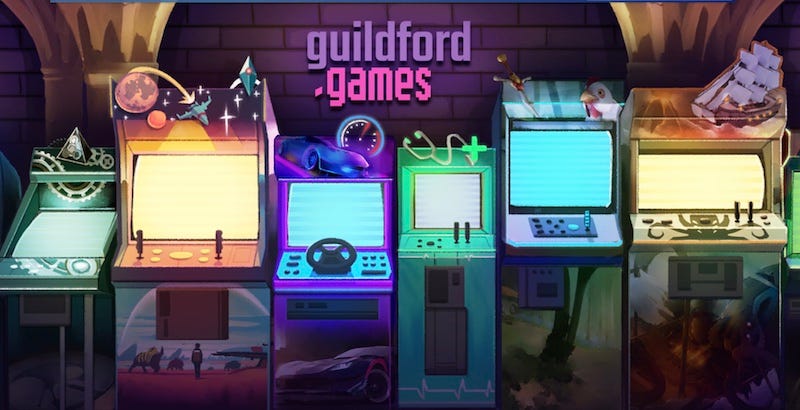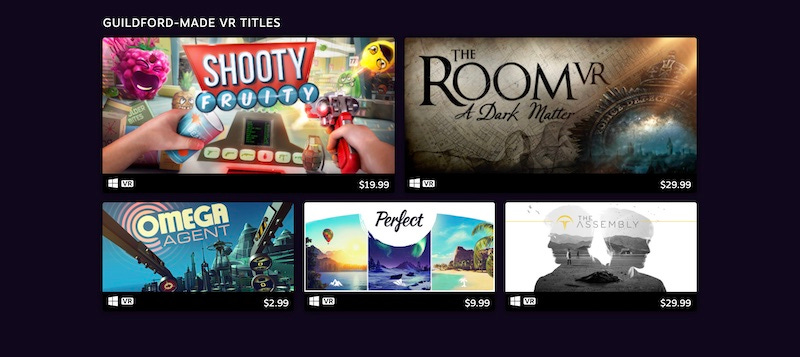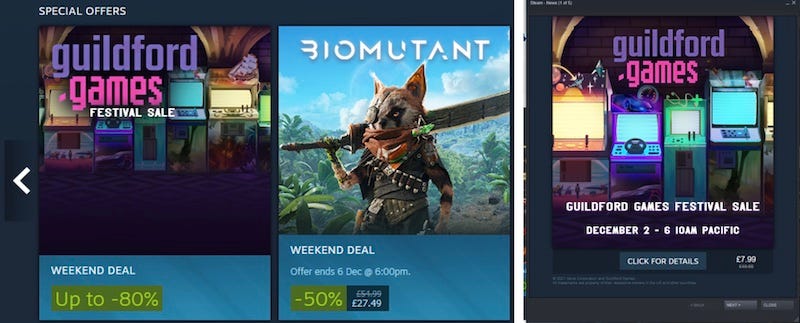Trending
Opinion: How will Project 2025 impact game developers?
The Heritage Foundation's manifesto for the possible next administration could do great harm to many, including large portions of the game development community.

Featured Blog | This community-written post highlights the best of what the game industry has to offer. Read more like it on the Game Developer Blogs or learn how to Submit Your Own Blog Post
Ever transparent goodness from our friends in Guildford.

[The GameDiscoverCo game discovery newsletter is written by ‘how people find your game’ expert & GameDiscoverCo founder Simon Carless, and is a regular look at how people discover and buy video games in the 2020s.]
It’s midweek madness over here at GameDiscoverCo, which means two things: 1. it’s Taco Wednesday (I’m not sure why we don’t do Taco Tuesday, but just roll with it?) 2. We have so much information to send you again that we’re struggling to fit it in a ‘Gmail length email’. But we’ll scrimp and save characters until we get it right.
Also, wanted to provide an update on the VR game dev survey we announced in Monday’s newsletter. Due to dev feedback, we’ve added a section on App Lab, Quest’s ‘off-store’ section. (It has around 800 games in it nowadays, and some of them are selling pretty well.) If you’ve got a game in App Lab, feel free to fill out the survey too!

[As a guest section, we’re delighted to welcome back Gary Burchell of Fireblade Software (Abandon Ship, SENTRY), a veteran UK dev who wrote up for us his experiences organizing the Guildford Games Festival sale on Steam in late 2020. Well, the sale based around the OG home of Bullfrog happened again in December - here’s his notes on metrics, strategies & more.]
The themed Guildford Games Festival 2021 sale on Steam ran from Thursday 2nd December 10am PT to Monday 6th December 10am PT. It coincided with the main Guildford Games Festival (henceforth known as “GGF”) which ran on 3rd December, with an awards ceremony taking place the evening before on the 2nd.
During the preparation of the Steam presence for the inaugural GGF in 2020, I got the sense that this was a one-time deal and that Valve were fatigued by the frequency with which they are approached for these types of cross-publisher sales.
Fast forward to less than a month before GGF 2021 was due to take place and I’d just recorded an interview for the festival, and was reminded of the high quality content that was being created. At the same time, the “Digital Tabletop Sale” had just finished, and I hadn’t put Abandon Ship forward, thinking it not applicable – and was then disappointed to see many games that were had little to do with board games (or ones with the most tenuous association) change their tags to be eligible.
This made me realise that everyone else is taking advantage of the system, so why am I not trying to do another Steam-based GGF? After all, we had high quality games, broadcast content, and a successful previous event. With thoughts of “you don’t ask, you don’t get” and realising the worst that can happen is to be told “no”, I reached out to Valve.
They were receptive to the idea, and like last year granted a special discount option to select, which made it easier to coordinate discounts across participants.
My initial goal for the GGF Steam page was to:
Help lift the Guildford games cluster into a global spotlight
Have a tangible impact on local developers (particularly indies) by providing visibility resulting in wishlists and sales
Provide an income boost with the participation of Abandon Ship
Help drive some wishlists to an early store page for our game SENTRY
These goals remained the same for 2021.

With less than a month before the festival commenced, myself and Sam Read (my partner on last year’s Steam page) had a lot of work to do in a short space of time. We’d laid a lot of groundwork previously, so were able to set up the page and message participants quickly with the news and instructions on how to add their discount.
The video content was already in-progress, as it was the main feature of the festival, and we did a test prior to the event to ensure it broadcast to the sales page correctly. Creating the page so late would not have been possible without the work put into last year’s GGF.
The page was set up in a very similar fashion to 2020, with the games put into groups based on user review scores, sorted randomly within those groups for fairness. Specialised sections like VR Games or the “Coming Soon” section were placed near the bottom of the page.
I’d agreed with Valve to review the page one week before the event started. This meant we had the artwork and games in place, as well as most of the discounts having been entered.
I felt that having a nice looking page, along with the duration of our broadcast content showed Valve that we were professional and taking this seriously, which would certainly not harm our chances of featuring.
We were granted a “Weekend Deal”, which meant:
A capsule on the front page in the “Special Offers” carousel
A pop-up message when you log into Steam
In addition, every participating game had a banner at the top of their store page that linked to the GGF sales page. This was fantastic news, as it makes the difference between a massively successful event and one with very limited reach in comparison.

I’ve been asked multiple times why I feel like we’ve got featuring for two festivals, particularly when some bigger events get less or no featuring. I’ll be honest; I don’t know. Valve remains understandably enigmatic in this area. I put it down to a combination of the following:
Good timing (i.e. it doesn’t clash with anything)
The featuring coinciding with a real event with high quality broadcast content
The page having a certain threshold of games, both in terms of quantity and quality
Some unknown factor outside of my control - maybe someone at Valve likes the idea or theme, maybe I’ve just been lucky, who knows?!
26 participating games were discounted when the feature commenced, including titles like No Man’s Sky, Two Point Hospital, Need For Speed Heat & The Room. This rose to 32 games over the next couple of days (I’m assuming that some people realised they hadn’t discounted all their games, or the message arrived late).
For those who have received featuring before, if they’re anything like me they’re petrified of some unforeseen consequence impacting the featuring. Thus far, I’ve never had anything go wrong with previous instances… except this one.
I had two issues occur:
Clicking the capsule image on the “Special Offers” carousel didn’t lead to the GGF page, it just reloaded the front page of Steam. I discovered this moments after the featuring went live, and sent an apology-laden email to Valve, worried I’d done something wrong on my end. This was fixed within approximately 20 minutes.
Instead of leading to the sales page, clicking the pop-up message led to my game Abandon Ship! When the feature commenced, I logged in and out of Steam a couple of times, but the pop-up message did not appear. It wasn’t until a couple of hours later when I logged into my personal account it appeared, and I clicked on it to test. I messaged Valve and they responded promptly, saying they’d fixed it.
Valve explained that both problems were caused by the way they link to the sale page event, and that it can occasionally be “janky”. With something as important as featuring, I feel it’s always good practice to verify yourself things are working as soon as the event goes live.
For our own title, during the summer we held our ‘Age Of Sail’ naval combat & exploration game Abandon Ship at a 50% discount. But knew we had a host of end-of-year sales occurring in quick succession, and felt it was appropriate to go slightly deeper - as we graduated from Early Access two years ago in October 2019.
Starting from the Halloween Sale & including Indie X (a Portuguese indie festival), the Autumn Sale and the GGF, we decided to have all of the discounts at 60%. This was so that anyone who purchased the game in late October wouldn’t feel cheated at seeing the game discounted more a couple of weeks later. (Obviously, all the other third-party titles in the promotion picked their own discount percentages.)
The festival-specific video talk content was scheduled to commence on the morning of the 3rd December. The user account broadcasting this was given “highest” priority, meaning that they would be displayed at the top regardless of viewer counts.
Last year, Abandon Ship and Gloomhaven broadcast throughout the entire weekend, generating extremely good numbers (that weekend, the Abandon Ship peak concurrent viewers reached 6,435, while the total unique viewers amounted to 680,359).
We sent an email to all participants explaining how to broadcast and offered assistance if they needed it, citing the numbers above to show that is was worth doing. However, only Abandon Ship and Gloomhaven broadcast again, which was disappointing.
This year, the Abandon Ship broadcasting stats were as follows:
Broadcast duration = 120 hours (+1 hour versus 2020)
Max concurrent viewers = 4,733 (-1,702 versus 2020)
Total unique viewers = 529,677 (-150,682 versus 2020)
While these are lower this year, they’re still good numbers that I’m pleased with. At various points on Thursday and Friday, both Abandon Ship and Gloomhaven received enough viewers to surface to the front page broadcast section.
As with last year’s event, once the official broadcast commenced with its priority forcing it to place higher, this started to syphon viewers from both games. Sam Read, who was responsible for broadcasting the official festival content confirmed it received the following stats:
Max concurrent viewers = 5,391
Total unique viewers = 2,216,195
While lower than the previous year, they’re still a huge success for us.

The stats break down as follows:
GGF 2020 “Reads” (which is page visits) = 1,740,914
GGF 2021 = 1,421,358 (-319,556 versus the year before)
We’ll never know how many visits were lost due to the two issues mentioned in the “Featuring Bugs” section. While accounting for this may still not have equalled 2020’s event, the numbers would have been closer.
As for the performance of participating games, I reviewed the Global Top Sellers chart every day the festival was featured. I did this three times a day, evenly spaced apart. This resulted in 12 checks across the five days, and barring when the sale first went live, at all times there were between 9 and 13 participating games in the top 500.
The best performance I noted was at Monday as the sale ended, where there were 12 participating games in the top 300 global charts. The highest position reached was 13th. In 2020, the most games that appeared in the top 500 Global Sellers were 17 participants. The highest position reached was 6th.
These were Abandon Ship’s Steam page traffic stats for the duration of the feature:

The click-thru rate is lower than our lifetime stats. Net wishlists went up by several thousand during the sale, by the way.
As with last year’s event, surfacing to the front page through the broadcast section massively balloons your impressions but destroys your click-thru rate (this received 926K impressions, so just over 21% of our impressions, with a 0.5% click-thru rate).
Compared to 2020’s event, we sold 51% more copies. However because of the reduction in price (30% discount in 2020, versus 60% in 2021) we made approximately 20% less gross revenue.
43.74% of our sales were from wishlist purchases, which is consistent with featured sales, but lower than non-featured ones. This is likely down to three factors:
We’ve had three very recent sales (Halloween, Indie X and Autumn) that would have triggered wishlist emails. All three of those sales were the first times we’d reached 60% off, so people waiting may have already purchased.
The discount amount probably contributed to more people who had little/no prior contact with the game deciding to give it a shot
The power of front-page featuring always draws in more people than your wishlists.
The 2021 stats for our sci-fi action-defense FPS title SENTRY were as follows:

The impressions were significantly lower this year, but the click-thru rate and visits were higher than in 2020. I put this down to the following factors:
Lower impressions due to: Lower GGF page visits; The “Coming Soon” section being further down the page (because there were more games this year); The GGF artwork had less of a vertical aspect to it; The “Coming Soon” section had twice as many titles in it as last year.
Higher visits/click-thru rate due to: An improved capsule image; Improved screenshots in the auto-pop-up when hovering over the capsule.
Net wishlists increased by over 2,300, an increase of approximately 50% on the previous GGF. I attribute the increase to the quality of the store page; last year the project was in its infancy, whereas we’re now approaching the end of pre-production and can show more representative gameplay. (Sadly, the event came too soon for our announcement trailer and big marketing push).
Although at times putting this event together felt time-pressured, it was another big success, and completely worth doing. Once again, the power of being on the front page provides visibility the GGF could not achieve on its own.
The amount of work these cross-publisher sales require should never be underestimated. Corralling this many developers and games can often feel like “herding cats”. Despite more advanced notice in future, there aren’t many places we can make the process easier for local studios (all they need to do is say “yes” to partake, and place a discount in their back end if they wish).
Festival marketing stats were in general lower when compared to the inaugural event. But 2.2M unique views on the official video content plus 1.42M page visits are still fantastic numbers.
As we’ve now held the second event through Steam in as many years, we’ll certainly revisit this approach annually. Whether we are granted a page, special discount option or featuring is not to be assumed however - and is ultimately up to Valve’s discretion.
Read more about:
Featured BlogsYou May Also Like